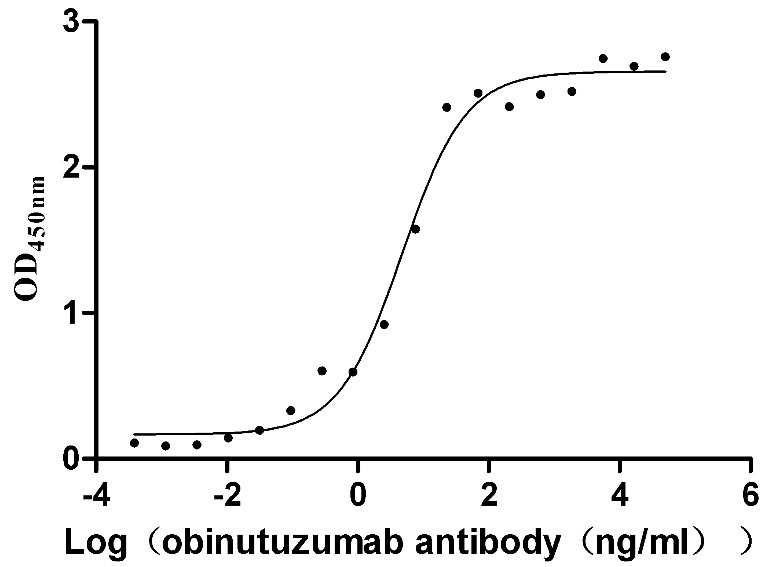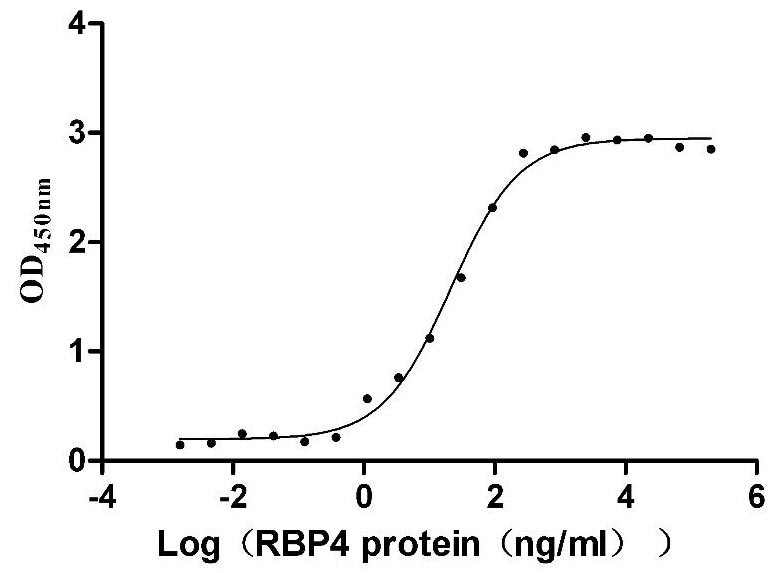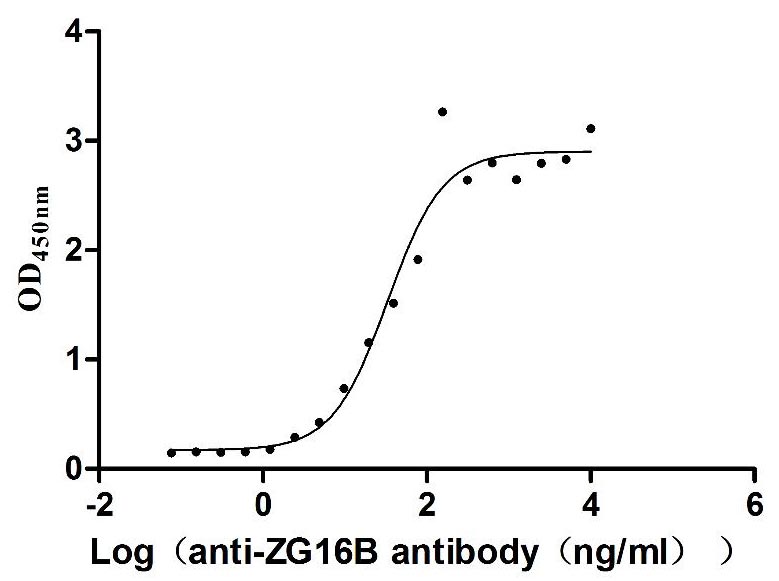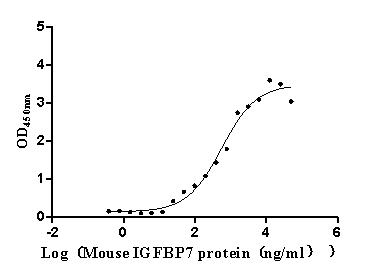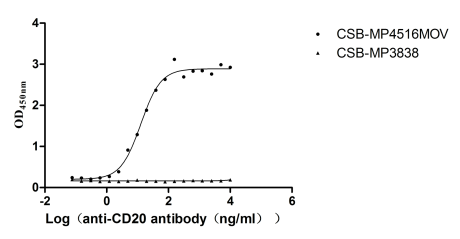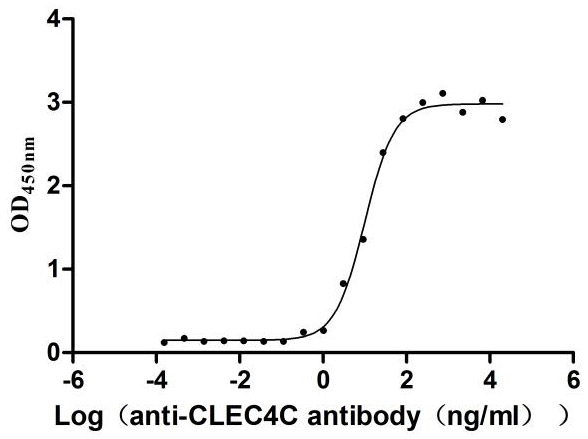Recombinant Human 5'-AMP-activated protein kinase subunit beta-1 (PRKAB1 AMPK)
-
中文名稱:
-
貨號:CSB-YP889918HU
-
規(guī)格:
-
來源:Yeast
-
其他:
-
中文名稱:
-
貨號:CSB-EP889918HU
-
規(guī)格:
-
來源:E.coli
-
其他:
-
中文名稱:
-
貨號:CSB-EP889918HU-B
-
規(guī)格:
-
來源:E.coli
-
共軛:Avi-tag Biotinylated
E. coli biotin ligase (BirA) is highly specific in covalently attaching biotin to the 15 amino acid AviTag peptide. This recombinant protein was biotinylated in vivo by AviTag-BirA technology, which method is BriA catalyzes amide linkage between the biotin and the specific lysine of the AviTag.
-
其他:
-
中文名稱:
-
貨號:CSB-BP889918HU
-
規(guī)格:
-
來源:Baculovirus
-
其他:
-
中文名稱:
-
貨號:CSB-MP889918HU
-
規(guī)格:
-
來源:Mammalian cell
-
其他:
產(chǎn)品詳情
-
純度:>85% (SDS-PAGE)
-
基因名:AAKB1
-
Uniprot No.:
-
別名:5'-AMP-activated protein kinase subunit beta-1; AMPK subunit beta-1; AMPKb; PRKAB1 AMPK
-
種屬:Homo sapiens (Human)
-
蛋白標(biāo)簽:Tag?type?will?be?determined?during?the?manufacturing?process.
The tag type will be determined during production process. If you have specified tag type, please tell us and we will develop the specified tag preferentially. -
產(chǎn)品提供形式:Liquid or Lyophilized powder
Note: We will preferentially ship the format that we have in stock, however, if you have any special requirement for the format, please remark your requirement when placing the order, we will prepare according to your demand. -
復(fù)溶:We recommend that this vial be briefly centrifuged prior to opening to bring the contents to the bottom. Please reconstitute protein in deionized sterile water to a concentration of 0.1-1.0 mg/mL.We recommend to add 5-50% of glycerol (final concentration) and aliquot for long-term storage at -20℃/-80℃. Our default final concentration of glycerol is 50%. Customers could use it as reference.
-
儲存條件:Store at -20°C/-80°C upon receipt, aliquoting is necessary for mutiple use. Avoid repeated freeze-thaw cycles.
-
保質(zhì)期:The shelf life is related to many factors, storage state, buffer ingredients, storage temperature and the stability of the protein itself.
Generally, the shelf life of liquid form is 6 months at -20°C/-80°C. The shelf life of lyophilized form is 12 months at -20°C/-80°C. -
貨期:Delivery time may differ from different purchasing way or location, please kindly consult your local distributors for specific delivery time.Note: All of our proteins are default shipped with normal blue ice packs, if you request to ship with dry ice, please communicate with us in advance and extra fees will be charged.
-
注意事項(xiàng):Repeated freezing and thawing is not recommended. Store working aliquots at 4°C for up to one week.
-
Datasheet :Please contact us to get it.
相關(guān)產(chǎn)品
靶點(diǎn)詳情
-
功能:Non-catalytic subunit of AMP-activated protein kinase (AMPK), an energy sensor protein kinase that plays a key role in regulating cellular energy metabolism. In response to reduction of intracellular ATP levels, AMPK activates energy-producing pathways and inhibits energy-consuming processes: inhibits protein, carbohydrate and lipid biosynthesis, as well as cell growth and proliferation. AMPK acts via direct phosphorylation of metabolic enzymes, and by longer-term effects via phosphorylation of transcription regulators. Also acts as a regulator of cellular polarity by remodeling the actin cytoskeleton; probably by indirectly activating myosin. Beta non-catalytic subunit acts as a scaffold on which the AMPK complex assembles, via its C-terminus that bridges alpha (PRKAA1 or PRKAA2) and gamma subunits (PRKAG1, PRKAG2 or PRKAG3).
-
基因功能參考文獻(xiàn):
- we studied the role of the beta 1 subunit in erythrocytes and observed microcytic anemia with compensatory extramedullary hematopoiesis together with splenomegaly and increased osmotic resistance. PMID: 27666489
- Salicylate activates the AMP-activated protein kinase (AMPK) by binding at the A-769662 drug binding site on the AMPK beta1-subunit PMID: 25940306
- findings suggest that the reduced expression of AMPK-beta1 confers lower AMPK activity, which enhances the oncogenic capacity of advanced-stage ovarian cancer. PMID: 24602453
- The effects of ethanol on AMPK and PP2A may result in activation of ChREBP, providing another potential mechanism for ethanol-induced hepatic steatosis. PMID: 23266705
- Data indicate that a diet high in iron improves glucose tolerance by activating AMPK through mechanisms that include deacetylation. PMID: 23515442
- LKB1 controls IRS1-dependent adipogenesis via AMPK in white adipose tissue. PMID: 23396401
- Changes in translational control of mitochondrial proteins are signaled by the activation of AMPK and general control non-derepressible kinase 2 (GCN2), leading also to the activation of autophagy. PMID: 22435535
- Phosphorylation levels of AMPK and glycolysis were up-regulated to confer an advantage of survival for MERRF skin fibroblasts. PMID: 22001850
- Adipose tissues of markedly obese insulin resistant individuals uniformly show decreased AMPK activity and increased oxidative stress compared with insulin sensitive patients. PMID: 22323564
- Adiponectin could attenuate renal dysfunction associated with mesangial cells disorders through AMPK-mTOR signal pathway. PMID: 22105511
- 1q21.1 copy number variant (CNV) results in gene function changes, specifically in the deletion containing lymphobalst cell lines, where AMPK was attenuated. PMID: 21824431
- AMPK, Akt and mTOR pathways have roles in resveratrol-enhanced prostate cancer cell response to ionizing radiation PMID: 22029423
- cisplatin-triggered activation of AMPK and subsequent suppression of mTOR activity can induce an autophagic response that protects tumour cells from cisplatin-mediated apoptotic death PMID: 20196784
- LKB1-AMPK negatively regulated mTOR function in tumor. PMID: 21859551
- NT5C1A suppression promotes AMP-activated protein kinase (AMPK) phosphorylation and metabolism in human and mouse skeletal muscle PMID: 21873433
- Inactivation of fumarate hydratase drives a metabolic shift to aerobic glycolysis in FH-de fi cient kidney tumors resulting in decreased levels of AMP-activated kinase. PMID: 21907923
- Phosphorylation of AMPK by Ulk1 represents a negative feedback circuit. PMID: 21460634
- Androgen deprivation and hypoxia augmented AMPK activation and triggered autophagy in androgen-dependent prostate cancer cells. PMID: 21554950
- Glucose deprivation resulted in activation of AMPK and inhibition of Akt phosphorylation PMID: 21570709
- Glucose restriction or treatment of human diploid fibroblasts (HDFs) with the activators of the AMPK/p53 pathway induced the expression of IFI16 protein. PMID: 21573174
- results of this study show that AMPK induces MUC5B expression through the p38 MAPK signaling pathway in airway epithelial cells. PMID: 21619869
- The connections between AMPK and FoxO3A, are reviewed. PMID: 20190568
- The aim of this study was to investigate the effects of adiponectin on StAR protein expression, steroidogenic genes, and cortisol production and to dissect the signalling cascades involved in the activation of StAR expression. PMID: 21334384
- High AMPK expression is associated with ovarian carcinoma. PMID: 21271224
- AMPK is abnormally activated in tangle- and pre-tangle-bearing neurons in Alzheimer's disease and other tauopathies. PMID: 20957377
- Endoplasmic reticulum stress triggers suppression of AMPK while increasing C/EBPbeta and pCREB expression which activates PEPCK gene transcription. PMID: 20797423
- There is a mutual suppressive interaction between AMPK and Akt. PMID: 21042744
- AMPK-mediated PLD1 activation is required for (14)C-glucose uptake through ERK stimulation PMID: 20231899
- The LKB1/AMPK/TSC tumor suppressor axis is functional in acute myeloid leukemia. PMID: 20668229
- These results suggest that the modification introduced by the laforin-malin complex could affect the subcellular distribution of AMPK beta subunits. PMID: 20534808
- Data suggest that AMPK is required for the serum starvation-related increase in insulin-stimulated glucose transport, with ATM as a possible downstream effector. PMID: 20810907
- The nuclear translocation of GAPDH might be regulated by the PI3K signaling pathway acting mainly as a nuclear export signal and the AMPK signaling pathway acting as a nuclear import signal. PMID: 20177150
- These observations support a role for AMPK in the regulation of Na+-coupled glucose transport. PMID: 20334581
- AMP-activated protein kinase inhibition mediates hepatitis C virus genome replication and lipid accumulation PMID: 20534540
- Data demonstrate that autophagy depends on the early activation of the AMP-activated protein kinase (AMPK)/mTOR-mediated pathway. PMID: 20083895
- Data showed that HDL-induced activation of AMPK is dependent on both sphingosine 1-phosphate receptors and scavenger receptor class B type I. PMID: 20018878
- Data suggest that upregulation of adipose triglyceride lipase and suppression of hormone-sensitive lipase and AMP kinase signaling mediate high-fat diet-induced alterations in lipolysis and lipid utilization in adipocytes. PMID: 20107043
- findings suggest that CCL2 hyperactivates mTORC1 through simultaneous regulation of both AMPK and Akt pathways and reveals a new network that promotes prostate cancer: CCL2-AMPK-mTORC1-survivin. PMID: 20019839
- Chlorophyll a up-regulated the AMPK and p-AMPK levels, and down-regulated the expression of PPAR-gamma. PMID: 19963029
- we will examine the evidence that AMP-activated protein kinase and SIRT1 both regulate each other and share many common target molecules--REVIEW PMID: 20103737
- These results indicate that AMPK activators facilitate the activation by TRAIL of an apoptotic cell death program through a mechanism independent of AMPK and dependent on the down-regulation of cFLIP levels. PMID: 19896469
- It is necessary to clarify the tissue-specific and stress-specific activation mechanism of AMPK--REVIEW PMID: 19911004
- AMPK is a novel and biologically significant participant with a tumor suppressive activity in the mitotic/cytokinetic phase of the cell cycle. PMID: 19844168
- Calmodulin-dependent protein kinase kinase-beta activates AMPK without forming a stable complex. There is a synergistic effects of Ca2+ and AMP. PMID: 19958286
- Data show that AMPK activation suppressed Ox-LDL-induced macrophage proliferation by suppressing GM-CSF expression and inducing cell cycle arrest. PMID: 19843515
- AMP-activated protein kinase has a role in gene expression in single islet beta-cells [review] PMID: 15289653
- Dipyridamole, an adenosine transporter inhibitor, and 5'-amino-5'-deoxyadenosine, an adenosine kinase inhibitor, blocked the effect of AICAR on the down-regulation of the insulin receptor protein, mRNA, and promoter activity. PMID: 15694368
- Reduced activation of AMPK by globular adiponectin in obese and obese type 2 diabetic subjects is not caused by reduced adiponectin receptor expression. PMID: 15769985
- it is likely that the AMPK-GDE association is a novel mechanism regulating AMPK activity and the resultant fatty acid oxidation and glucose uptake PMID: 15886229
- These results suggested that the combination of 5-FU and genistein exert a novel chemotherapeutic effect in colon cancers, and AMPK may be a regulatory molecule of COX-2 expression, further implying its involvement in cytotoxicity caused by genistein. PMID: 15896711
顯示更多
收起更多
-
蛋白家族:5'-AMP-activated protein kinase beta subunit family
-
數(shù)據(jù)庫鏈接:
Most popular with customers
-
Recombinant Human B-lymphocyte antigen CD20 (MS4A1)-VLPs (Active)
Express system: Mammalian cell
Species: Homo sapiens (Human)
-
Recombinant Mouse Transthyretin (Ttr) (Active)
Express system: Mammalian cell
Species: Mus musculus (Mouse)
-
Recombinant Human Pancreatic adenocarcinoma up-regulated factor (ZG16B) (Active)
Express system: Mammalian cell
Species: Homo sapiens (Human)
-
Recombinant Mouse Complement component C1q receptor (Cd93), partial (Active)
Express system: Mammalian cell
Species: Mus musculus (Mouse)
-
Recombinant Macaca fascicularis Membrane spanning 4-domains A1 (MS4A1)-VLPs (Active)
Express system: Mammalian cell
Species: Macaca fascicularis (Crab-eating macaque) (Cynomolgus monkey)
-
Recombinant Human C-type lectin domain family 4 member C (CLEC4C), partial (Active)
Express system: Mammalian cell
Species: Homo sapiens (Human)


